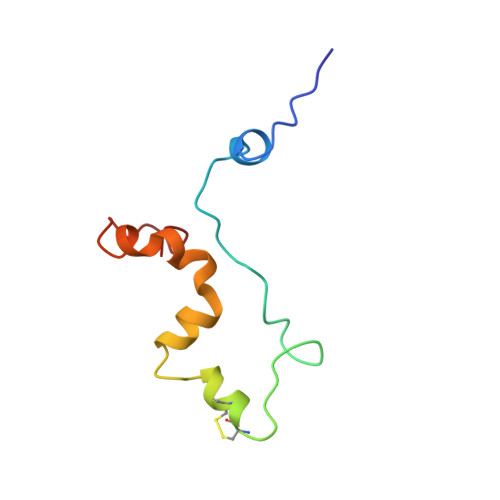Trifluoroethanol stabilizes a helix-turn-helix motif in equine infectious-anemia-virus trans-activator protein.
Sticht, H., Willbold, D., Ejchart, A., Rosin-Arbesfeld, R., Yaniv, A., Gazit, A., Rosch, P.(1994) Eur J Biochem 225: 855-861
- PubMed: 7957222
- DOI: https://doi.org/10.1111/j.1432-1033.1994.0855b.x
- Primary Citation of Related Structures:
1TVS - PubMed Abstract:
The solution structure of the 75-amino-acid trans-activator (Tat) protein of the equine infectious-anemia virus in trifluoroethanol-containing solution was determined by two-dimensional and three-dimensional nuclear magnetic resonance spectroscopy, resulting in a total of 838 nuclear-Over-hauser-enhancement distance restraints, and restrained molecular-dynamics simulations. In contrast to the recently determined structure of this protein in trifluoroethanol-free pH 6.3 solution, the hydrophobic core and the adjacent basic RNA-binding region of the protein showed well-defined alpha-helical secondary structure in trifluoroethanol-containing solution. The helical regions comprise those parts of the molecule whose helix-forming tendencies were noted earlier in trifluoroethanol-free solution. Two helices (Gln38-Arg43 and Asp48-Ala64) are connected by a tight type-II turn centered at the strictly conserved Gly46 leading to a helix-turn-helix motif in the core and basic region of the protein. A third helix (Thr9-Asn13) is located in the less well defined N-terminal part of the protein. These observations may support the notion that the protein adopts a helical structure in the RNA-binding region on complex formation. Although the secondary-structure elements become better defined in trifluoroethanol-containing solution, the opposite is true for the hydrophobically stabilized tertiary structure. This adds a caveat to studies of protein structures in trifluoroethanol-containing solution in general.
Organizational Affiliation:
Lehrstuhl für Biopolymere und Bayreuther Institut für Makromolekülforschung (BIMF), Universität Bayreuth, Germany.














